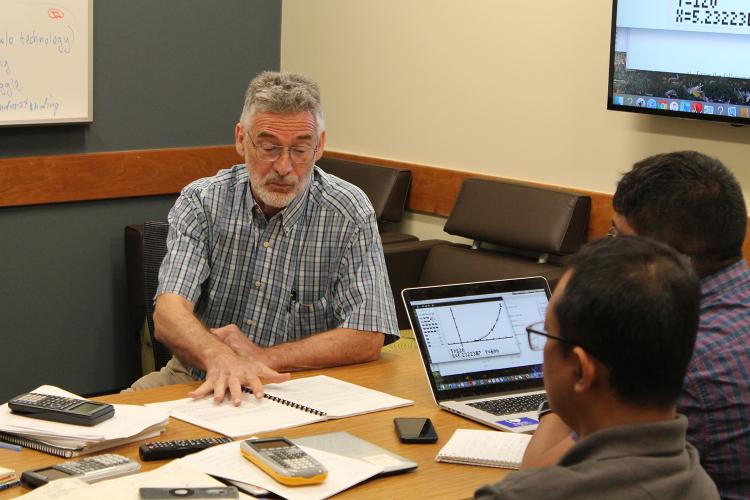
Patton College's mathematics doctoral program ranks in top 15 in country

The Patton College of Education boasts one of the most productive mathematics doctoral programs in the United States, according to Notices of the American Mathematical Society’s 2019 article, “Doctoral programs in mathematics education: A status report of size, origin of program leadership, and recommended institutions.”
Morton Professor of Mathematics Education Dr. Gregory Foley has led the program since 2007.
“I am extremely proud of Dr. Foley and our entire doctoral program,” said Patton College Dean Renée A. Middleton. “Through hard work, dedication, and sacrifice, our mathematics education program has become one of the nation’s best.”
According to the article, the numbers support that. From 1987 to 1996, Ohio University ranked 48th in the country in mathematics education doctoral graduates produced (three); from 1997 to 2006, it ranked 20th (12); and from 2007 to 2016, it ranked 24th (15). OHIO was one of just 32 institutions of higher learning to rank in the top 50 in all three 10-year periods.
Many people deserve credit for this, including Robert L. Morton, who established one of the first endowed professorships in mathematics education in the United States. Morton, an OHIO faculty member from 1918 to 1960, created the Morton Professorship endowment in 1973. The first Morton Professor, Leonard Pikaart, started the doctoral program in mathematics education at OHIO, and his successor, James E. Schultz, along with Bonnie Beach—who received her Ph.D. at OHIO under Pikkart’s supervision—produced 16 mathematics education Ph.D.s between them.
The program has been humming along ever since.
“Bob Morton’s generosity and vision are the key factors that have led to the three decades of productivity and success of the doctoral program in mathematics education at OHIO,” said Foley. “The close connection between faculty and students and the mentoring that advisers provide their student-scholars are hallmarks of successful doctoral programs. A key strength of our program is its ability to provide individualized programs of study tailored to the goals and aspirations of the program’s scholars.”
Drs. Robert Reys (University of Missouri-Columbia), Barbara Reys (University of Missouri-Columbia), Jeff Shih (University of Nevada-Las Vegas), and Farshid Safi (University of Central Florida-Orlando) authored the article.
Rankings were based on data gathered from the Survey of Earned Doctorates (SED), which began gathering data in 1920 and added mathematics education as a discipline in 1962. The SED is conducted annually and gathers data from every institution in the United States that awards earned doctorates. Thus, it provides the most comprehensive data available regarding the number of doctorates awarded in mathematics education.
There were 205 institutions of higher education that produced at least one doctoral graduate in mathematics education between 1987 and 2016. The number of doctoral graduates in mathematics education grew during each 10-year period from 734 (1987-1996) to 928 (1997-2006) to 1428 (2007-2016).
“Twenty-five years ago, due to demographic trends, there was an acute and growing shortage of university faculty, as well as applicants for faculty positions in mathematics education,” explained Foley. “The National Science Foundation responded with its Center for Learning and Teaching (CLT) program. The CLTs primed the pump that has led to this growth in doctoral production over the past three decades.”

Schultz, who served as Morton professor from 1994 to 2005, helped OHIO become a member of one of those CLTs: the Appalachian Collaborative Center for Learning, Assessment, and Instruction in Mathematics (ACCLAIM). Membership in this group, which includes University of Kentucky, University of Louisville, University of Tennessee, and West Virginia University, further enhanced OHIO’s doctoral program in mathematics education.
Foley, who became the third Morton professor more than a decade ago, has expanded the program with the help of Drs. George Johanson and Robert M. Klein and, more recently, Drs. Mathew D. Felton-Koestler, Allyson Hallman-Thrasher, and Courtney Koestler.
“OHIO and The Patton College have made key faculty hires to maintain and advance its doctoral program in mathematics education,” said Foley. “These faculty hail from the University of Georgia, University of Texas, University of Wisconsin, and The Ohio State University, all of which are recognized as exemplary in developing leaders in doctoral education.”
Recent graduates of the College’s doctoral program in mathematics education teach at University of Alabama, University of Dayton, Eastern Mennonite University, University of Northern Iowa, Ohio University, Pennsylvania State University-Harrisburg, Urbana University, Wingate University, University of Wisconsin-Stout, and Wright State University-Lake Campus, among other U.S. institutions of higher learning, as well as internationally at Prince Sultan University (Saudi Arabia) and King Faisal University.
OHIO also has the largest contingent of STaR fellows of any university in the United States this year, including the recent cohort of Drs. Ahmad Alhammouri (Jacksonville State University), Valerie Long (Indiana University of Pennsylvania), and Wayne Nirode (Miami University), who received their doctorates from OHIO in 2018, 2009, and 2012, respectively.
The Service, Teaching, and Research (STaR) Program is an induction program for early career mathematics educators working at institutions of higher education. The Association of Mathematics Teacher Educators (AMTE) runs the program, which was initiated through a grant from the National Science Foundation. It is designed to address common challenges related to developing leadership and service skills, teaching courses designed for pre- and in-service K-12 teachers, and establishing a research agenda.
Said Foley, “It is difficult to put into words how gratifying it is to see how the graduates of our program are flourishing as leaders and emerging leaders in mathematics education across Ohio, across the nation, and around the world.”
